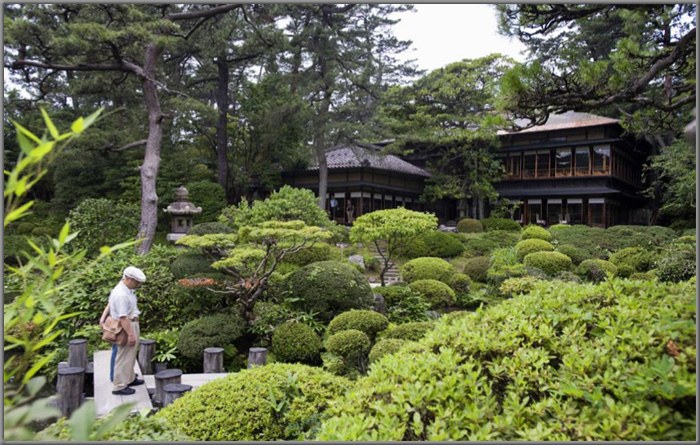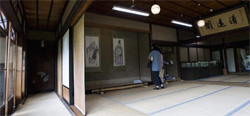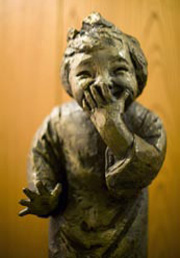Home > Highlighting JAPAN > Highlighting Japan AUGUST 2012 > Homma Museum of Art
Highlighting JAPAN
[SERIES] THE NATION’S MUSEUMS

The 200-year-old Kakubuen garden and Seienkaku “palace,” which is now the main building of the Homma Museum of Art in Sakata, Yamagata Prefecture.
Credit: ROB GILHOOLY
Homma Museum of Art
Summer is the perfect time to visit the Homma Museum of Art, which boasts a 200-year-old garden of beautiful abundant greenery. Julian Ryall enjoyed a leisurely look around.

Visitors look at scrolls in the first-floor reception room of the museum’s main building.
Credit: ROB GILHOOLY
“The people of the city of Sakata love that mountain and it has become a symbol of our region,” says Akio Tanaka, curator of the museum. “And that is why it was important for the designer of the garden to incorporate it into the garden.”
The Seienkaku, the main building of the villa whose name translates to “palace view pure Mount Chokai,” and the gardens were constructed in 1813 by the fourth head of the Homma family. The Daimyo Sakai (1813–1873) often stayed at the villa when he inspected his holdings in the region, while nobles from the Imperial Palace and high-ranking government officials have also stayed here. The villa’s most famous guest was the future Emperor Showa, who visited in place of his sick father, Emperor Taisho in 1925. Now on two floors after a second was added in anticipation of the visit of the Emperor Taisho in 1908, the building features spacious tatami mat floors and walls dusted with gold. Scrolls depicting scenery and animals are hung in the alcoves. On the ground floor is a tea room called the Rokumeiro, meaning six windows and a hearth, while the upstairs is spacious and bright with the scent of tatami in the air.

Bronze work “Yorokobu shojo” (Elated Girl) by the revered sculptor Seibo Kitamura. The work was presented to the museum to commemorate the opening of the museum’s annex in 1968.
Credit: ROB GILHOOLY
From the villa, the viewer would look over the garden—which the feudal lord Sakai named the Kakubuen, meaning dancing crane garden, because one of the elegant birds had landed near the site of the gazebo—and to the mountain in the distance.
As the visitor explores the paths through the garden, surprises await around each corner. A stone lantern and a red torii gateway, a tiny shrine hidden amid a stand of bamboo, and two arched bridges that bisect the pond. Birds sing in the trees.
The villa and the garden were turned into an art museum by the Homma family in 1947. The early displays included works loaned by other old local families in this area, but the collection soon grew as works were purchased or donated.
Of all the exhibits, the dolls are among the most popular. The Hakusen Bunko Collection was donated in 1964 and includes no fewer than seventy sets of precious classic dolls and more than 200 figures.
The number of works soon outgrew the space available in the villa, and a new exhibition building was completed in 1968. Over two stories, the annex rotates the more than 2,500 items that make up the collection, including celadon bowls that date back to the Koryo Dynasty in Korea, hand-thrown raku tea bowls created by the master potter Chojiro, and paintings by Kuroda Kiyoteru and Maruyama Oukyo.
When this writer visited the works on display incorporated the natural themes—fish, birds, plants, trees, rocks, waterfalls—that can still be seen in the neighboring garden.
| The Homma Museum of Art | |
| Address: | 7-7 Onari-cho, Sakata-shi, Yamagata-ken, 998-0024, Japan |
| Phone Number: | +81 234 24 4311 |
| Fax.: | +81 234 24 4312 |
| Website: | http://www.homma-museum.or.jp/ (Japanese) |
| Hours: | Closed on Mondays and between December 22 and January 7. |
| Entrance: | 900 yen for adults, 400 yen for students and free for junior high school pupils and younger children. |
© 2009 Cabinet Office, Government of Japan






